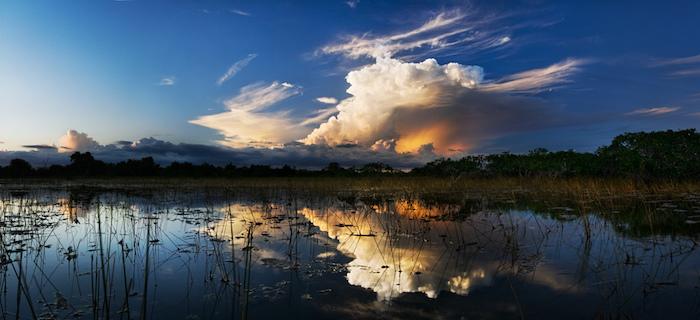
How close is too close to Everglades National Park for an exploratory oil well to be drilled?/NPS, Brian Call
While oil exploration continues in Big Cypress National Preserve in Florida, another drilling case has cropped up that, while not necessarily posing an imminent threat to Everglades National Park, sparks the question of how close is too close when the largest designated sub-tropical wilderness area in North America is at risk of contamination?
Five miles from the national park might reasonably be deemed too close to drill for oil. But what about ten miles? Or 50?
Last week, a unanimous First District Court of Appeal in Florida ruled (see attachment below) that the state's Department of Environmental Protection strayed too far from the facts and leaned on what ifs when it overturned an administrative law judge's decision that Kanter Real Estate, LLC, should be permitted to explore for oil in western Broward County in an area less than 50 miles north of Everglades National Park.
"It was an abuse of discretion to reject, modify, or substitute the ALJ’s factual findings, and when 'the reasons for the change are legally insufficient, it is entirely appropriate to remand with instructions to approve the hearing officer’s recommendation'," the ruling stated.
From Kanter's viewpoint, an expert's opinion that they have a 23 percent chance to strike a commercially productive reserve, one that theoretically could produce between 180,000 and 10 million barrels of oil, makes the site inviting. State environmental officials, however, tossed aside that prediction as unreliable and pointed to the Florida Legislature's passage in 1991 of the Everglades Forever Act to restore the 'river of grass' in overruling the administrative law judge.
The three judges on the appellate court said the DEP was wrong to point to the Everglades Forever Act "and inferences derived therefrom" since it had not been part of earlier discussions over the permit. More so, the judges noted that the act "does not prohibit exploratory oil drilling."
The ruling gains heightened attention both because of the drill site's location, which is technically within the "river of grass" that nourishes the Everglades, and because of longstanding efforts to restore the water flows through the Everglades.
"The entire watershed of the Everglades is connected, so (the National Parks Conservation Association) is absolutely troubled about the prospect of oil drilling that would impact Everglades National Park," Cara Capp, NPCA's Everglades restoration program manager, told the Traveler on Friday. "Drilling in the 'river of grass' is dangerous, and threatening water resources while we are simultaneously investing millions of taxpayer dollars to restore the Everglades is illogical. This is not the right path forward to protect the resources that we’re trying to restore.”
But is the drill site a risk to the Everglades? According to the court's ruling, the 5-acre site is located in an area known as "the Pocket," which is "hydrologically isolated from both surface and groundwater and is environmentally degraded and overrun with cattails."
And yet, it also is within Florida's Water Conservation Area 3, the largest in the state. The conservation area is located within the historic footprint of the Everglades, and is used to receive floodwaters from Lake Okeechobee. It also sends water on to Everglades National Park as well as Big Cypress National Preserve, according to the South Florida Water Management District.
An independent energy consultant in Texas who writes a column for Forbes called fears over the drilling project unfounded.
"... the alarmist scenarios spread by activists shouldn't concern the citizens of Florida. What they really should be concerned about is the inadequate and outdated state of the regulations that DEP is charged with enforcing," David Blackmon noted in his column.
"Most states with healthy, economy-driving oil and gas industries, like Texas, Colorado, Wyoming and North Dakota, have done a fine job of modernizing their regulations and keeping them up to date in recent years," he wrote. "But Florida had not done that, which helps to explain why the issuance of a simple drilling permit ends up taking four years and going through several rounds of court decisions. DEP officials are forced to try to enforce a set of regulations that is full of holes and leaves too many factors open to broad and often arbitrary interpretation."
While the appellate judges returned the matter to the DEP with an order to issue the permit, Kanter still needs to gain a permit from the U.S. Army Corps of Engineers, according to Capp at NPCA. For now the park advocacy group is watching how the state responds to the court ruling.
“We know that the state of Florida has the opportunity to challenge this decision. Of course, the state is a major partner in restoring the Everglades, so we don’t know if the state will challenge the decision, but certainly NPCA would support that action because we know it threatens our Everglades and our water, so we’re waiting to see what the next steps will be,” she said.









Comments
save our National Parks and waterways!! The Everglades is important for south Floridians to have water!!!!